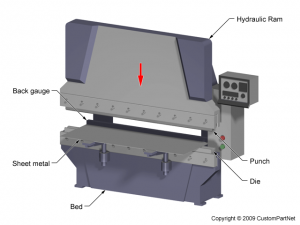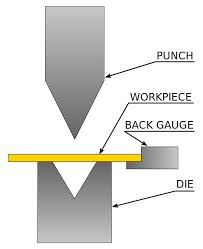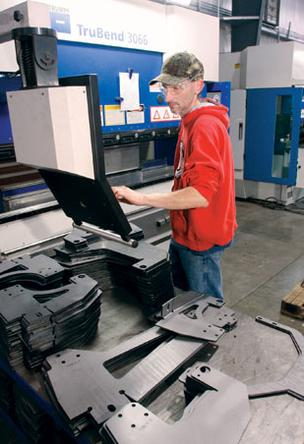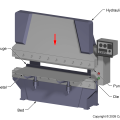 A press brake (also referred to as a brake press) is a machine that is used to bend material (such as sheet metal). Pre-determined bends are formed, when the workpiece is clamped between a punch and a die.
A press brake (also referred to as a brake press) is a machine that is used to bend material (such as sheet metal). Pre-determined bends are formed, when the workpiece is clamped between a punch and a die.
This type of machine usually is equipped with a wedge shaped die (upper portion), that forces the metal down and into a V-shaped die that bends the metal.
Some of the main parts of press brakes include:
End Frames (also referred to as the “housing”) are a heavily constructed support system for the machine.
The brake carries the material without causing any disruption of the form.

A bolster plate is the part that supports and correctly positions the die assembly.
The bed is the stationary surface for the lower blade.
The ram is the part that carries the upper blade. It is usually positioned on the front of the end frames and moves vertically.
The gib provides an easy sliding area for the ram, and the drive gives vertical propulsion to the slide.
When shopping for a press brake for sale, it is important that you go into the experience educated, and know exactly what you are looking for – especially when considering a used press brake.
Some of the more popular brands of press brakes include: Niagara, Wysong, Cincinnati, and Chicago and each come in a variety of sizes, with many different types of options.
Small Press Brakes are categorized as being less than 25 tons. Although a small press brake is good only for constant light work, many shops have a smaller press as a back up to their main system.
When looking at smaller press brakes for sale, the following things should be taken into consideration:
- The bed should not be bolted to the frame, but it should be welded.
- The bed and the ram should be big enough to prevent deflection.
- Steel gearing is recommended on small brake presses.
- A small press brake should have at least two speed options and a ram position indicator.
Hydraulic Press Brakes are one of the safest types of systems, but they are also considered to be one of the most costly. Although they have better control and accuracy, they are generally slower in the overall process.
Basically, there are two large forms that a piece of sheet metal is pressed between. The pressure of the press is created via liquid movement, and the ultimate goal is to form the metal into certain types of shapes.
A minor disadvantage, to a hydraulic press brake machine, is the fact that it must remain properly lubricated or the entire machine will seize. It may seem cumbersome and time consuming, but the disaster that could occur, if the machine is not well lubricated, certainly outweighs any inconvenience that it may require, to keep this machine functioning properly.

Brake press operator
A brake press operator is the person who controls the machine that assists in the shaping and bending of sheet metal.
Being able to read blueprints is an important prerequisite of being a brake press operator, in addition to being able to take accurate measurements, and to feed raw material into the machine.
CNC press brakes are commonly found in large plants, and automatically bends and punches holes into material, according to instructions that are programmed into the computer by the operator.
Other important skills needed to be brake press operator include:
- Due to the fact that a brake press machine has multiple levels and settings that need to be constantly adjusted – it is important that an operator have exemplary and steady motor skills.
- Mathematical and analytical skills are also important to a press brake operator, because they must interpret blueprints/templates/drawings, and read gauges and other measurements, to make proper adjustments to the machine.
- In addition, they should have a background of effectively and confidently using power (and hand) tools, such as anvils, grinders and hammers.
- Excellent organization skills are a quality that every brake press operator should possess, at it comes in handy when arranging material necessary at the start of each new job.
The duties that a brake press operator will be performing include:
- Inspecting material before and after pressed.
- Operators are expected to keep work area and machines clean and organized.
- All company policies and procedures must be known and followed.
- Basic maintenance of the equipment (such as filter and oil change) is a duty of a brake press operator, and necessary to ensure that the machine is running properly.
Brake press operators can make a steady salary of approximately $50K a year.
CNC brake presses
A brake press operator needs to be specially trained to operate this highly complex piece of machinery.
By reading/studying blueprints (plans), the CNC brake press operator makes a determination on the exact angles and dimensions needed to achieve the final results. Once all the information is inputted, the operator then feeds the sheet metal into the base (or feeding bar) of the machine to begin the process.
After the piece has been made, the operator must carefully inspect the finished product, to ensure that it meets all the specifications. If necessary, the operator can make adjustments to the programmed code and start the process from the beginning.
